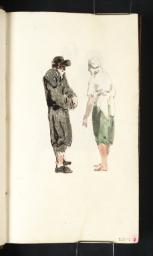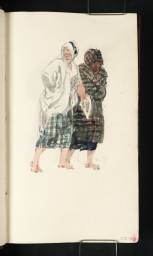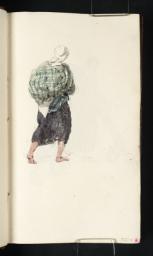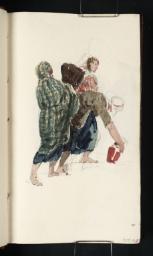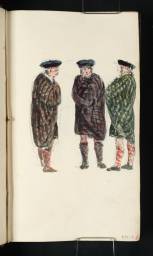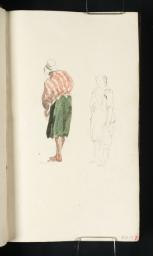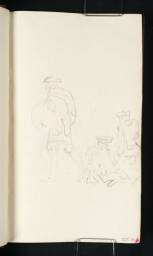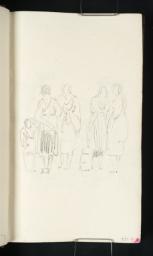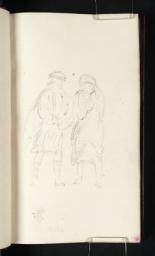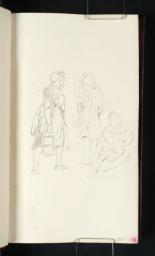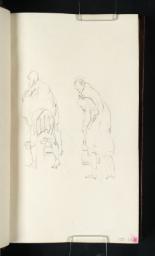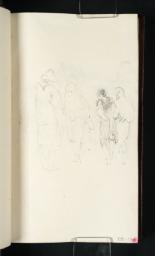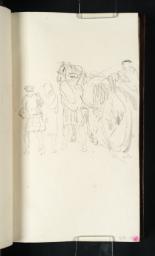Turner Bequest LIX 1–186
Sketchbook bound in boards covered in calf leather, gold–tooled at edges and spine, with one brass clasp (broken)
187 leaves of white wove paper; page size 156 x 92 mm
Numbered 224 as part of the Turner Schedule in 1854 and endorsed by the Executors of the Turner Bequest on recto of front flyleaf in ink ‘No 224 | 17 Scotch Figures | some in Colors some in | Pencil – | H. S. Trimmer’ and in pencil ‘JPK’ and ‘C.L.E.’ towards top
Blind–stamped with Turner Bequest monogram on front cover
187 leaves of white wove paper; page size 156 x 92 mm
Numbered 224 as part of the Turner Schedule in 1854 and endorsed by the Executors of the Turner Bequest on recto of front flyleaf in ink ‘No 224 | 17 Scotch Figures | some in Colors some in | Pencil – | H. S. Trimmer’ and in pencil ‘JPK’ and ‘C.L.E.’ towards top
Blind–stamped with Turner Bequest monogram on front cover
Accepted by the nation as part of the Turner Bequest 1856
References
This little sketchbook is one of the nine that Turner took with him on his tour to Scotland in 1801; the others are the Smaller Fonthill, Helmsley, Chester, Guisborough Shore, Dunbar, Edinburgh, Scotch Lakes and Tummel Bridge books (Tate; Turner Bequest XLVIII, LIII, LXXXII, LII, LIV, LV, LVI, LVII). He apparently designated it a repository of ideas for ‘staffage’: figures observed in his travels that might be incorporated into topographical views. He was to embark on a similar exercise on his journey to Switzerland the following year, with the Swiss Figures sketchbook (Tate; Turner Bequest LXXVIII), also containing studies of figures, singly or in groups, wearing local costume. In both cases the project petered out, and in each only a handful of pages is used.
In attempting to create a compendium of figures for use in his landscapes, Turner anticipated by just a year or two the first published exercise of this kind, W.H. Pyne’s 1803 Microcosm: or, a Picturesque Delineation of the Arts, Agriculture, Manufactures, &c. of Great Britain, in a Series of above a Thousand Groups of Small Figures for the Embellishment of Landscape.1 The drawing on folio 7 recto (D03447), with its two unrelated figures, draws attention to fact that for the most part these studies depict groups in active interrelationship. That on folio 13 recto (D03453) is particularly expressive of the toilsome lives of the Scottish peasantry. The fact that they form a small group, apparently all observed around the same time, suggests that the drawings were made in or around Edinburgh, rather than during Turner’s speedy transit of the Highlands. He made his studies rapidly in pencil, but elaborated several of them with watercolour.
The uncoloured pencil drawings at the other end of the book (folios 183 verso, 184 verso, 185 verso; D03626, D03628, D03630) relate to a different phase of Turner’s journey; some of them probably show the same canal as the studies of similar scenes from the contemporary Smaller Fonthill sketchbook, as discussed under D03630.
Finberg records Turner’s lost paper ‘label on back [i.e. the spine]: “50 Scotch f...” (rest of label has been torn off’.2 He also notes John Ruskin’s inscription on an associated wrapper: ‘224. Scotch Figures. Curious in its present form. One leaf cut out.’3 Inside the front cover is a note by British Museum Curator Arthur Magyer Hind in pencil at the top left, ‘Leaf 5a missing’; this was inscribed following the transfer of the Turner Bequest works on paper after the 1928 Tate Gallery flood. Finberg had apparently seen the work, and included it in his 1909 sequence of entries for the individual pages as ‘5a. Two women walking. Water colour. (This is the leaf which Mr. Ruskin cut out.)’4 It was allocated the Tate accession number D03445 when the sketchbook re–entered the collection in 1987, but was recorded then as missing, and remains untraced.
Technical notes
How to cite
Andrew Wilton, ‘Scotch Figures sketchbook 1801’, sketchbook, May 2013, in David Blayney Brown (ed.), J.M.W. Turner: Sketchbooks, Drawings and Watercolours, Tate Research Publication, April 2016, https://www


